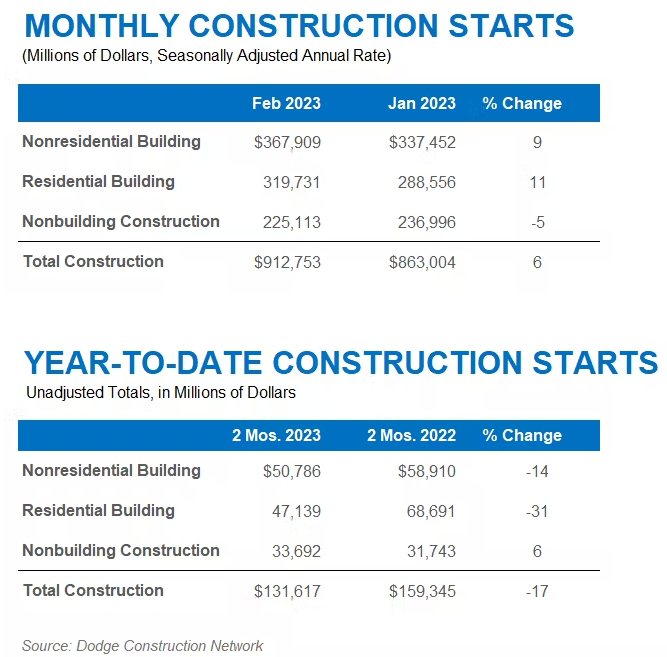Manufacturing starts soared for the month, combining with rebounding residential work to offset declines in commercial and institutional building projects.
HAMILTON, NJ — Total U.S. construction starts rose 6% in February to a seasonally adjusted annual rate of $912.8 billion, according to Dodge Construction Network. During the month, residential and nonresidential building starts rose 11% and 9% respectively, and nonbuilding starts declined by 5%.
For the first two months of 2023, total construction starts were 17% below that of 2022. On a year-over-year basis, residential starts were down 31%, nonresidential starts were off 14%, while nonbuilding starts gained 6%. For the 12 months ending February 2023, total construction starts were 9% higher than the 12 months ending February 2022. Nonresidential and nonbuilding starts were 27% and 19% higher respectively, while residential starts lost 9%.
“February construction starts were a mixed bag that led to marginal growth,” said Richard Branch, chief economist for Dodge Construction Network. “Single family units posted a gain for the first time in 13 months, and manufacturing starts continued to be very robust, showing signs of promise early into 2023. However, the downturn in commercial and institutional building starts could very well be the beginning of an anticipated slow-down as the construction sector pulls back in the face of higher interest rates and lagging economic growth. While this ebbing should be comparatively mild, some construction verticals could face extreme stress as the year progresses.”
Nonbuilding construction starts fell 5% in February to a seasonally adjusted annual rate of $225 billion. This primarily resulted from a 30% decline in environmental public works starts and a 5% loss in highway and bridge starts. On the plus side, utility/gas plant starts rose 68% and miscellaneous public works starts were up 6%.For the 12 months ending February 2023, total nonbuilding starts were 19% higher than the 12 months ending February 2022. Utility/gas plant starts rose 23%, and highway bridge starts increased 17%. Environmental public works and miscellaneous nonbuilding starts were up 19% and 18%, respectively, on a 12-month rolling sum basis.
The largest nonbuilding projects to break ground in February were the $1.2-billion Trumbull Energy Center combined-cycle natural gas plant in Warren, OH, the $540-million Merit SI Gulfstar solar farm in Wharton County, TX, and the $530-million Mockingbird Solar Center in Brookston, TX;
Nonresidential building starts gained 9% in February to a seasonally adjusted annual rate of $368 billion. Driving the gain was a 218% gain in manufacturing starts due to the start of a large EV battery plant in Ohio. Commercial starts decreased 2% in February as office and parking structure starts fell, offsetting increases in retail, hotels and warehouse activity. Institutional starts also fell during the month, following a decline in education and healthcare projects. For the 12 months ending February 2023, total nonresidential building starts were 27% higher than the 12 months ending February 2022. Manufacturing starts were 91% higher, and both institutional and commercial starts gained 18% on a 12-month rolling sum basis.
The largest nonresidential building projects to break ground in February were the $3.5-billion Honda EV battery plant in Jeffersonville, OH, the $1.4-billion expansion of Concourse D at Hartsfield Jackson Airport in Atlanta, GA, and the $500-million Apex-1 Sustainable Lithium-Ion battery plant in Hopkinsville, KY.
Residential building starts rose 11% in February to a seasonally adjusted annual rate of $320 billion. Single family and multifamily starts rose 4% and 22% respectively. For the 12 months ending in February 2023, residential starts were 9% lower than the 12 months ending in February 2022. Single family starts were 20% lower, while multifamily starts were up 18% on a rolling 12-month basis.
The largest multifamily structures to break ground in February were a $350-million mixed-use building in New York, the $215-million Four Season condominium in Washington, DC, and the $140-million Palomar Heights mixed-use building in Escondido, CA.
Regionally, total construction starts in February rose in the Northeast, Midwest, and South Central regions, but fell in the South Atlantic and West.
Dodge Construction Network leverages an unmatched offering of data, analytics, and industry-spanning relationships to generate the most powerful source of information, knowledge, insights, and connections in the commercial construction industry.
The company powers four longstanding and trusted industry solutions—Dodge Data & Analytics, The Blue Book Network, Sweets, and IMS—to connect the dots across the entire commercial construction ecosystem.
Together, these solutions provide clear and actionable opportunities for both small teams and enterprise firms. Purpose-built to streamline the complicated, Dodge Construction Network ensures that construction professionals have the information they need to build successful businesses and thriving communities. With over a century of industry experience, Dodge Construction Network is the catalyst for modern commercial construction. To learn more, visit construction.com

IAPMO
IAPMO develops and publishes the Uniform Plumbing Code®,the most widely recognized code of practice used by the plumbing industry worldwide; Uniform Mechanical Code®; Uniform Swimming Pool, Spa and Hot Tub Code®; and Uniform Solar Energy, Hydronics and Geothermal Code™ — the only plumbing, mechanical, solar energy and swimming pool codes designated by ANSI as American National Standards — and the Water Efficiency Standard (WE-Stand)™. IAPMO works with government, contractors, labor force, and manufacturers to produce product standards, technical manuals, personnel certification/educational programs and additional resources in order to meet the ever-evolving demands of the industry in protecting public health and safety.
Last modified: March 28, 2023

